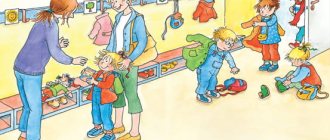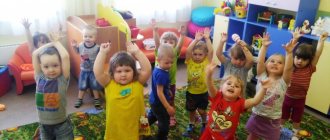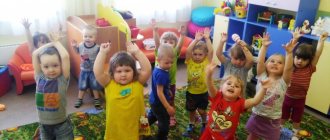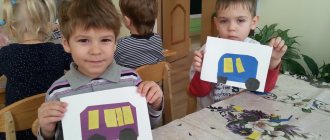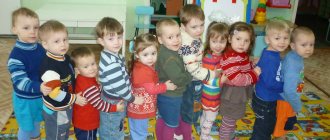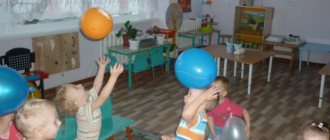Preparatory viewing:
“Plan of personal work with children of the 2nd junior group”
For January 2022
Attitude to work.
- D/ game “Help feed the doll” - learn to name dishes and food products.
- D/ game “Helpers” - learn to identify objects for various professions.
- D/ game “Show the picture” to teach how to determine what adults are doing.
- D/ game “dress the doll” - self-service and helping others.
- D/ game “Tools for work” - teach to recognize objects for work.
- D/exercise “Assignment” - learn to help adults and friends.
- D/ exercise “Where does garbage live?” - teach to maintain order and cleanliness.
- D/ game “Wonderful Bag” - learn to identify geometric shapes.
- D/game “Guests” - teach to identify many and one”
- D / game “Help the bear” - find high - low, wide - narrow.
- D/ game “Tracks” - one, many, counting up to 3.
- D/ game “Assemble a pyramid” - fixing color and size.
- D/ game “Stringing huge and small rings” - size and counting.
- D/ game “Building a tower from cubes” - size, color.
- Finger games.
- Games with geometric shapes - “Assemble a pattern, any object - a Christmas tree, etc.
- D/ game "Harvest" - count to 3.
- D/ game “Fly the ball” - up, down, on, under.
- D/ game “Colored sticks” - colors, placement on a sheet.
- D/ game “Balloons” - colors, shapes.
- D/ game “Collect a picture” - colors, shapes, placement.
- Mosaics, lacing, stencils, coloring books, crayons - development of small motor skills
- D/ exercises “Finish, add, add”, “pick up” - the skill of holding a brush or pencil correctly.
- D/ exercises “What’s extra” - development of attention.
- D/ game “What color is the car, doll” - color, parts, bodies.
- D/ game “Which” - distinguish and name colors
- D/ exercises “Drawing in the air” - development of the hand.
- Finger gymnastics, with objects.
- Evelina
- Sasha
- Ulyana
- Anya
- Ksenia
- Anita
D/ game “Wonderful Box” to expand the stock of understandable words.
D/ game “Show the picture” - distinguish details, reinforce correct pronunciation.
D/ game “Repeat the nursery rhyme, poem” - finish words, phrases, memorize.
D/ game “Water” - experience with objects and reinforcement of memorization of nursery rhymes.
D/ game “Repeat” - learn to create animal sounds.
D/ exercise “Guess what it sounds like” - sound pronunciation exercise.
D/ exercise “Toy Exhibition” - form an active vocabulary, repeat after an adult.
D/ game “Guess who came to us” - an exercise in sound pronunciation.
D / game “Guess and name” - the purpose of objects, to activate words.
D/ game “Recognize by voice” - sound pronunciation, imitation.
Card file (junior group) on the topic: Personal work with children of the 2nd junior group “December”.
2nd junior group.
Personal work in special moments.
Speech development, simple mathematical concepts, visual arts, reading fiction.
Methodology for individual work with children in the younger group
It is known that every child is unique. It has its own characteristics of the nervous system and psychophysical development. The individual characteristics of a child influence his acquisition of skills and abilities and his attitude towards others. Observation of a child in everyday life, analysis of his behavior and activities, conversations with parents allow the teacher to plan tasks, methods, and content of individual work.
Children who do not regularly attend kindergarten due to illness or other reasons, children who are “weakened”, have low performance in class, are shy, slow, inhibited and pedagogically neglected, need especially close attention. When planning individual work, the teacher must take into account the mental and individual characteristics of the child.
Individual work with children is carried out in the morning and evening hours, as well as during walks.
Individual lessons with children who have gaps in knowledge are recommended to be organized primarily in the form of a game. The play partner can be an adult or another child
In the first half of the day, the teacher does a lot of individual work with the kids. For example, he organizes special games and exercises with those who need to correct speech deficiencies or who are lagging behind in any movements. He works with inactive and withdrawn children, giving them various assignments that require communication with adults and peers. Children who are not inquisitive enough are entrusted with interesting observations (for example, how a hamster eats and puts grains in its cheeks, tits that have flown to the site, admiring the beauty of a winter morning, etc.).
In the afternoon, the teacher conducts individual work with children on the development of movements, drawing, cutting, designing, and correcting speech defects.
During walks, the teacher conducts individual work with children: for some, he organizes a game with a ball, throwing at a target, for others - a balance exercise, for others - jumping from tree stumps, stepping over trees, running down hills. During walks, work is also done to develop the child’s speech: learning a nursery rhyme or a short poem, reinforcing a difficult sound to pronounce, etc. The teacher can recall with the children the words and melody of a song that they learned in a music lesson.
Methods of individual training in the junior group :
- Using an example, following the example of a teacher;
- In interaction with the teacher;
- Modeled after peers;
- Using the help of peers;
- On the recommendation of narrow specialists.
The form of organization of work is individual, however, in some cases it is possible to carry out work by organizing children into small groups. When carrying out individual work on a walk, it is necessary to take into account seasonality and weather conditions. Individual work with children during regime processes is planned (education of cultural and hygienic skills, independence, development of speech, movements, etc.) and is conducted by the teacher throughout the day, in all regime moments, in any type of activity.
The quality of individual work depends on the teacher’s ability to “see” children. The emotional state of the child during classes is very important. And here the role of the adult is great. The psychological and emotional mood of the classes depends only on him. A smile, encouragement, and sincere interest in what the adult is teaching the child will create the background against which the child will have a desire to learn. When working with children, I advise reading poetry, asking riddles, and using elements of dramatization. In addition to the aesthetic and cognitive value for the child, this creates the right atmosphere, relieves tension and will allow both you and the child to use class time more effectively.
ANNEX 1
An example of planning individual work at special times in a junior group for a week.
MONDAY
.
Morning time.
1. Collective and individual conversations with children to develop speech activity and enrich the vocabulary of preschoolers.
2. Mastering the basics of hygienic culture: Washing, behavior at the table, dressing, in a playful way, caring for things and toys. in independent activities.
3. Outdoor games of low and medium activity.
4. Working with fairy tales - repeating previously read fairy tales, reading a new fairy tale, watching a cartoon based on a read fairy tale, looking at illustrations of a famous fairy tale. -a new ending to the fairy tale, adding new heroes to the fairy tale, how to help the hero of the fairy tale, etc.
Walk
1. Observation of wildlife.
2. Individual work to develop creative abilities (collect the most beautiful autumn bouquet, what does a cloud look like?, show how a fox walks, etc.).
3. Organize collective gaming activities.
Evening time.
1. Labor education - familiarization with the work of adults (various forms of work).
2. Plot-role-playing game. To develop skills and desire to participate in gaming activities.
3. Preparing for a math lesson.
TUESDAY
.
Morning time.
1 Introduction to the objective world: an idea of objects, their name, structure, names of parts, purpose, how and where they can be used: clothes, shoes, furniture, toys, transport, vegetables, fruits, etc. cognitive and speech skills, attitude to the objective world.1. Mastering the basics of work. Self-service, development of work skills in everyday life, attitude to work.
2. Individual exercises in appliqué, drawing and sculpting.
3. Inspection of the kindergarten premises, examination of furnishings, household items, getting to know the preschool educational institution employees and their professions.
Walk.
1. Observation of inanimate nature.
2. Individual work with children on speech development.
3. Introducing a new outdoor game.
4. Develop children's gaming skills.
Evening time .
1. Listening to musical children's works: songs, musical fairy tales, musical fragments from cartoons.
2. Child and book - reading, retelling, looking at new books, folders with pictures, albums, helping the teacher repair books.
3. Game activity: outdoor games with text, round dance (we develop tempo, rhythm, teach onomatopoeia).
4. Individual work with children (psychological relief, overcoming emotional discomfort).
WEDNESDAY.
Morning time.
1. Formation of the foundations of environmental education, plant world - name, plant characteristics, growth and development, comparative analysis, plant care, - animal world - name, general concepts, structure, relative size, location, needs, care. - a friendly attitude towards all living things.
2. Games with construction sets to develop finger motor skills.
3. Individual work to develop hygiene skills (play activities).
4. Memorization, consolidation and repetition of poems, nursery rhymes, songs, counting rhymes, riddles.
Walk.
Thematic walk (at the choice of the teacher, at the request of the children, according to the program). Conversation, story or observation in accordance with the topic. Organization of outdoor activities in accordance with the teacher’s tasks (walking, outdoor themed games, consolidation of motor skills). Use imitation games, facial exercises, miniature games (mini theater).
Evening time.
1. Entertainment: -concerts, meetings with older children, -puppet, table, shadow theatres, -sports activities, -mask festival, -celebration with parents.
2. Introducing and explaining the rules of a new board game for the development of speech, sensory, and logic.
3. Individual work to develop intellectual abilities.
THURSDAY.
Morning time.
1. Cognitive development: Adults give concepts and comparative analysis, Children form an emotional state, I myself develop practical skills. My family
2. Collective exercises in applique, modeling, drawing in joint activities of an adult and a child.
3. Work in a corner of nature.
4. Consolidation of dance and motor skills using musical accompaniment.
Walk.
Getting to know society. Hiking around the neighborhood. Conversations “My street”, “My kindergarten”, “Shop” “Road” (familiarization with the phenomena of social life). Individual work on orientation in time and space.
Evening time.
1. Familiarity with the rules of the road. The first rules for life safety
2. Individual outdoor play activity with objects (hoop, ball, chair, handkerchief, etc.)
3. Gaming activities: HRE, gaming skills, learning dialogues, gaming situations.
4. Preparing for the next day's classes.
FRIDAY
.
Morning time.
1. Exhibition of children's works in fine arts, examination of crafts made from natural materials, and, if necessary, complete the collective work.
2. Consolidation of motor skills: construction, restructuring, rhythmic exercises, basic movements. To develop in children a desire to play sports, correct posture, and precise execution of commands.
3. Formation of moral qualities through the creation of play situations with dolls and toys.
4. Development of intellectual abilities - games, tasks.
Walk.
Observing people. Adult labor. Age characteristics. Communication culture. Relationships with older preschoolers. Mobile activities at the request of children. Individual consolidation of knowledge on the development of coherent speech, vocabulary development, and grammatically correct speech.
Evening time.
1. Games with sand and water
2. Construction with large cubes, cubes, Lego constructor.
3. Play activities at the request of children.
4.Creating conditions for gaming activities (GRI).
APPENDIX 2
Cyclogram of individual work with children of the younger group
Sample lesson plan
Of course, each parent decides for himself how to conduct developmental activities at home with his children, but you can take the proposed plan below as a basis, choosing from it what his child needs at 3-4 years old.
Physical exercise
No development can be complete without physical activities with the child. This item can include anything, it is related to the child’s data, taking into account his and the parent’s wishes.
Home physical training is no less effective than in the gym
Everything should be carried out in a fun and light atmosphere; it would be good to turn on music, because in this way the baby will learn to move to it.
The main thing in this matter is not to overdo it, although this applies to all areas of development.
In addition, it is at home that you can determine the type of activity that your child likes and succeeds in. You can see his inclinations and send him to the appropriate section.
Development of fine motor skills of hands
Developmental exercises at this point are very important, because it is the development of fine motor skills that directly affects the development of the brain. It's no secret that the hands are directly connected to the head.
It is very good for children 3-4 years old to collect construction sets, mosaics, cubes, and here you can immediately repeat the colors and shapes.
In addition to motor skills, drawings using natural materials: pebbles, sand, shells develop the imagination very well.
Developmental toys for hand motor skills
Today, there are smart stores that will offer caring parents a rich assortment that will help them conduct educational lessons at home.
Creative lessons
Creativity develops the imagination well, these include: modeling, crafts, appliqué, drawing, including finger paints, various role-playing games, staging performances, puppet theater, shadow theater. These types can be listed endlessly, and 4-year-old children really love these types of activities.
Attention and memory training
It is very important to train memory and attention. Chess, checkers, and all kinds of dominoes are perfect for this. It’s good to train attention at home while playing; to do this, you can lay out 4-5 animals and change their places, while the child should turn away. Turning around, the baby must guess who swapped places with the teddy bear.
Board games for memory training
Reading
Children as young as 3 years old can begin to learn letters and sounds. This is a very important point. It’s good for children, when learning a letter to better remember it, to find it in a book, mold it from plasticine, or lay it out from pebbles. It would be nice to find it with your eyes closed in a plastic version. As you get acquainted, magnetic letters can be attached to the refrigerator so that they are in front of your eyes. Magnetic and plastic letters are also good for collecting syllables and words.
Important! During classes, parents should teach the child letters, while naming their sounds, that is, not “EL”, but “L”, not “BE”, but “B”, this will make it easier for the child to teach reading.
Check
Developmental exercises for 3-4 years should include learning to count, that is, the child can be introduced to ordinal counting up to 10. He can also lay out numbers from scrap materials and compose simple problems. At this age, mathematics is based on elementary logic, that is, with a little one you can look for a pair of an object, find an extra object.
Observations of the surrounding world must be active
Getting to know the world around you
At the age of 3-4 years, it is necessary to give the child basic concepts about our environment, we need to introduce him to animals, touching on the topic of domestic and wild, with the seasons, days of the week, precipitation, edible and inedible objects.
You should pay attention to such concepts as narrow - wide, high - low, large - small, long - short.
In addition, using the example of fairy tales, the topic of good and evil should be touched upon.
Child development is a very important process that needs to be carried out in a friendly and free manner; if the child is interested, then learning will happen faster and more effectively.
leave a comment
Choosing a time and place to work
In order for developmental activities for 4-year-old children to produce results, they must be regular. It is advisable to choose the same time and place at home. When choosing a time, it is necessary to take into account that the little one is alert, well-fed and active. You should experiment to see which time is most suitable.
Psychologists recommend in the morning or after a nap. You need to try to make work part of your daily routine.
Many parents wonder how long they should spend with their baby. The structure of the brain and the development of self-control in a 3-4 year old child allow him to withstand 15 minute lessons. However, with proper work and adaptation to the exercises, some children can easily withstand at least half an hour.
The first lessons should be no longer than 15 minutes
The first lessons usually do not exceed 10 minutes; you need to start small. As soon as the baby adapts, you can slowly increase the time, first up to 15 minutes. If he calmly endures it and remains cheerful and cheerful after that, then you can try increasing it to 20 minutes.
When choosing a place for daily work, first of all you need to pay attention to convenience. The workplace should be comfortable for both the baby and his mother, maybe it is a high chair with a table or a rug on which work takes place.
In what form should lessons be taught?
Classes for children under 5 years of age should be held exclusively in the form of games. This is necessary due to the mental characteristics of the baby, because play is the leading activity for him. This age already allows the baby to come up with stories, play actions, and act as a director, that is, he himself comes up with the rules of the game.
The game form of educational activities is most suitable for children 3-4 years old
A gaming atmosphere can be created through bright, colorful and interesting materials. This is what you need to focus on when choosing books. Books must have clear and colorful pictures. Black and white illustrations can bore your little one, and too bright and bright colors will distract him.
The necessary emotional background can be created through the toys that come to the lesson: “Pinocchio came to us today and brought different figures.”
You can also encourage children to compete, for example, who can choose circles and squares from a variety of geometric shapes the fastest.
Naturally, you shouldn’t forget to praise the baby.

